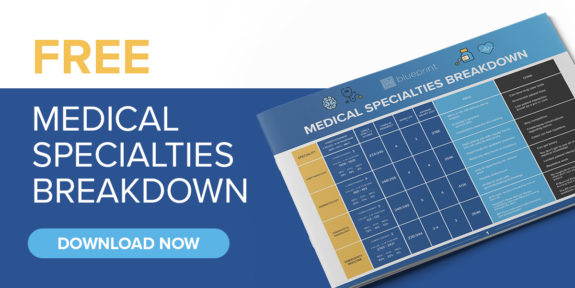A career as a surgeon is incredibly rewarding, stressful, and meaningful. As a surgeon, your patients put the highest level of trust in you and you’re responsible for their very lives when they’re on your operating table. Surgeons are exposed to an extremely wide range of pathologies with a high degree of complexity, and they get to combine medical knowledge with technical skills to change anatomy to help fix a pathology.
Here is a step-by-step timeline of becoming a surgeon and the stops along the way!
Looking for more of a clear breakdown and side-by-side comparison of each medical specialty? Find your path in medicine with the FREE Medical Specialties Breakdown Guide! Go beyond the data with qualitative insights from residents, practicing physicians, and med school tutors who have been in your shoes.
Typical Timeline to Become a Surgeon
The road to becoming a surgeon can be as varied as the surgeries they perform. The bare bones of it, however, is 4 years of undergraduate education, 4 years of medical school, and a 5–6-year residency followed by 1-3 years of a fellowship (if you so choose).Intermingled throughout these years may be research years, travel time, or entire careers, all of which help one become the best surgeon possible!
Premedical Years: ~4 Years
The first step on your journey to becoming a surgeon is getting your bachelor’s degree. Most people major in one of the sciences or applied sciences, such as biology, biochemistry, engineering, etc. But that doesn’t mean majors in English, art, and social science can’t go to medical school. People with those backgrounds have unique experiences, and they’re often some of the best students in a medical school class. To apply to medical school, part of your education must include required courses including physics, biology, chemistry, and organic chemistry. And you’ll have to take the MCAT, the first of many standardized tests on your journey to becoming a surgeon. The MCAT is an important and rigorous test that will challenge you. It’s usually taken towards the end of your third year in college, so it’s a good idea to get your required courses finished by then because they’re relevant for the MCAT.Excellent grades alone are not enough to get into medical school, however. Medical schools value life experiences as well. It’s a good idea during your undergraduate career to get involved in a club, volunteer in a hospital or at a clinic, and get research experience. Getting clinical experience is particularly important because it will help you understand more about what it is like and what it means to be a physician, so shadowing in the operating room is important. After those long, but important, undergraduate years and getting that acceptance, you’re finally going to medical school!
Medical School: 4 Years
Medical school is when you begin to develop into the type of physician you’ll be one day. This is when you start to learn the art of talking to patients, how to be part of a healthcare team, how to diagnose illnesses, and implement treatment plans. There are different curriculum models across the United States, so I’ll only discuss the most common version of medical school education.
Preclinical years: 2 Years
The preclinical years are often considered an extension of your undergraduate education. These years are spent in lectures and small groups building a massive foundation of medical knowledge. You’ll take the famed medical school anatomy course as well as biochemistry, pathology, pharmacology, and “systems based courses” in cardiology, neurology, pulmonology, etc. These preclinical years culminate in taking Step 1, the first of three medical licensing exams you’re required to pass to become a licensed physician. This test is now pass/fail, but studying hard for this is still vitally important as the knowledge you gain will help you shine during your clinical years. Your preclinical years are also when you want to start solidifying your interest in surgery or potentially discovering your passion for another specialty. Additionally, it’ll be important for a residency application to begin building a stellar medical CV with research endeavors, leadership roles, and volunteer activities. Finding a mentor within your specialty will help build connections and create opportunities to join research projects within the field. The preclinical years are also a good time to make your way to conferences to build a CV and connect with others in your field. After completing all of those courses and passing Step 1, you finally get to do what you came to medical school for: interacting with and caring for patients during your clinical years!
Clinical Years: 2 Years
The clinical years are when you begin interacting with patients and being a part of a team working to get them through what may be the hardest time in their lives. Rotations will include OB/GYN, family medicine, internal medicine, pediatrics, electives, and—most importantly if you are reading this blog — surgery! Being a good clinical medical student is part knowledge, part luck, and part being a great team player. Always being willing to help, proactive, thorough, honest, and eager to learn are key to becoming an honors student. At the end of each rotation, you’ll need to complete a “shelf” exam that will test what you learned throughout the rotation. These are a huge part of your rotation grade and there may be a cutoff for honors, so don’t take them lightly. Additionally, these exams are similar to questions you’ll see on Step 2 (which currently is still scored). You take this test at the end of third year and your score is used by residency programs to rank your application. On your surgery rotation, there are a few skills that will help you stand out amongst your peers. Being able to tie one-handed, two-handed, and instrument ties is extremely valuable. This will allow you to have more time closing port sites or maybe even incisions. Practicing a subcuticular stitch will also be important for getting more hands-on experience as well. Always being prepared for surgical cases and knowing the anatomy and a few broad steps of the procedure will also help you answer intraoperative questions and allow your talents to shine.As your time in medical school comes to an end, you’ll need to apply for the Match. After you write your personal statement, get strong letters of recommendations, and interview at many institutions, you’ll finally get that Matched email, be on your way to residency, and be able to call yourself a physician!
Medical School Alternative Paths
As with any step in this long process to becoming a surgeon, the standard 4-year medical school route is not for everyone. There are often opportunities to do a year of research, or possibly do an entire PhD in between years of medical school. These various paths are amazing additions to any residency application and are springboards to a career in academia and beyond. No matter the path chosen, you’ll gain valuable experiences that will make you a better physician for your future patients.
Residency: 5-6 Years
Residency is when your career as a physician truly begins. You’ve successfully navigated medical school and are now able to make decisions, while supervised, about the treatment of your patients. Many surgical residency programs are set up in a “graduated responsibility” format, in which you have more and more responsibility for your patients as you progress through residency.Some programs have built-in “professional development” years, when you may complete a variety of fellowships, a research year, and more. These are great ways to expand your capacity as a surgeon and bolster your application to fellowships at the end of residency. They’re also useful if you want to move directly into practice.At the end of residency and all of its ups and downs, there’s potentially one more hurdle prior to becoming a fully-fledged attending: fellowship.
Fellowship: ~1-3 Years
After a general surgery residency, the options for fellowship are immense. There’s plastic surgery, cardiothoracic, minimally invasive, vascular, bariatrics, critical care, and more. These programs have a variety of lengths. The goal of each is helping you to narrow your focus and shape your practice into what you want it to be. As a fellow, you’ll operate much more like an attending. You may work one-on-one with attendings or be the leader of a team including residents and medical students and have much greater autonomy compared to residents. At the end of fellowship training, and more than 10 years of post-high school education, you may finally call yourself an attending surgeon and have full responsibility for your patients!
Further Reading
How long does it take to become a surgeon? The journey is long and can vary widely, but in general you can expect at least 13 years of training after high school. All these years are to ensure you’re a safe, effective, and compassionate surgeon ready to help each of your patients.A career in surgery is extraordinarily rewarding and you can help patients in a way nobody else can. The end result is worth every minute of the long process. Best of luck if you choose this path, and please reach out if you have any questions! Looking for more (free!) content to help you find your path in medicine? Check out these other posts on the Med School blog:






